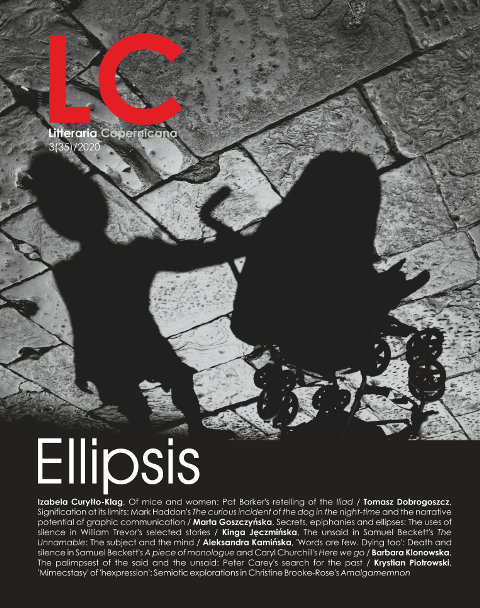‘Words are few. Dying too’: Death and silence in Samuel Beckett’s “A piece of monologue” and Caryl Churchill’s “Here we go”
DOI:
https://doi.org/10.12775/LC.2020.034Parole chiave
Samuel Beckett, Caryl Churchill, death, transcendental silenceAbstract
There is a widespread belief that since words, belonging to the temporal dimension and ultimately formulated by the body, bind the utterer to human reality, the transcendental must lie beyond language. Ewa Wąchocka (2005) proposes a category of “transcendental silence” to mark those moments in a dramatic text which transgress ordinary silences and pauses to hint at something much more profound and inexpressible. One of the famous proponents of “literature of silence” (Hassan 1968) as a means of “saying the unspeakable” is Samuel Beckett, who in his play A Piece of Monologue (1979) moves towards expressing the inexpressible through experimenting with silences and transcendental silence. Arguably, a similar concept is explored by Caryl Churchill in her play about dying (Here We Go, 2015), where silences as part of everyday human communication become the vehicle for touching upon transcendental silence in the final act. The article provides a brief overview of the role of silence in the works by the two playwrights, arguing that Here We Go brings Churchill especially close to the Beckettian aesthetics.
Zgodnie z powszechnym przekonaniem, skoro mowa, istniejąca w czasie i pochodząca z ciała, przywiązuje mówcę do doczesności, to co transcendentne musi przejawiać się poza językiem. Ewa Wąchocka (2005) proponuje kategorię „milczenia transcendentnego” do opisu momentów tekstu dramatycznego, które, wychodząc poza zwyczajną ciszę i pauzy, dotykają czegoś znacznie głębszego i wymykającego się ujęciu za pomocą mowy. Jednym ze słynnych twórców „literatury ciszy” (Hassan 1968) pojmowanej jako narzędzie do „wypowiedzenia niewyrażalnego” jest Samuel Beckett, którego sztuka Partia solowa (1979) sięga do niewyrażalnego poprzez eksperymentowanie z pauzami i milczeniem transcendentnym. Można uznać, że podobna koncepcja przyświeca Caryl Churchill w sztuce o umieraniu zatytułowanej Here We Go (2015), w której milczenie jako część codziennej komunikacji stopniowo ustępuje miejsca milczeniu transcendentnemu. Artykuł przedstawia krótkie omówienie roli milczenia w twórczości obydwojga autorów, sugerując, że w Here We Go Churchill bardziej niż kiedykolwiek wcześniej zbliża się do Beckettowskiej estetyki.
Riferimenti bibliografici
Angelaki, Vicky 2017. “Too Much Information: Caryl Churchill and Millennial Angst”. In: Vicky Angelaki. Social and Political Theatre in 21st-century Britain. London: Bloomsbury. 19–53.
Beckett, Samuel 2006. Complete Dramatic Works. London: Faber and Faber.
Ben-Zvi, Linda (ed.) 1990. Women in Beckett. Performance and Critical Perspectives. Urbana – Chicago: University of Illinois Press.
Brater, Enoch 1987. Beyond Minimalism. Beckett’s Late Style in the Theater. New York – Oxford: Oxford University Press.
Bryden, Mary 1993. Women in Samuel Beckett’s Prose and Drama. Her Own Other. Lanham: Barnes & Noble Books.
Bryden, Mary 1997. “Sound and Silence. Beckett’s Music”. Samuel Beckett Today / Aujourd’hui 6, 1: 279–288. Project Muse [10.05.2019].
Cage, John 2017. Silence. Lectures and Writings. London: Marion Boyars.
Carpenter, Charles A. 2011. The Dramatic Works of Samuel Beckett. A Selective Bibliography of Publications About his Plays and their Conceptual Foundations. London: Continuum.
Churchill, Caryl 2015. Here We Go. London: Nick Hern Books.
Cohn, Ruby 1993. “Ghosting through Beckett”. Samuel Beckett Today / Aujourd’hui 2, 1: 1–12. JSTOR [10.03.2019].
Colin, Marjorie 2017. “Le silence en maux dans l ’oeuvre théâtrale de Samuel Beckett”. Quêtes littéraires 7: 142–152.
Diamond, Elin 2006. “Caryl Churchill: Feeling Global”. In: Mary Luckhurst (ed.). A Companion to Modern British and Irish Drama 1880–2005. Malden – Oxford: Blackwell. 476–487.
Diamond, Elin 2008. “Beckett and Caryl Churchill along the Möbius Strip”. In: Linda Ben-Zvi and Angela Moorjani (eds.). Beckett at 100. Revolving It All. Oxford – New York: Oxford University Press. 285–298.
Hassan, Ihab Habib 1968. The Literature of Silence. Henry Miller and Samuel Beckett, New York: Alfred A. Knopf.
Holmberg, Arthur and Paul Schmidt 1988. “A Conversation with Robert Wilson and Heiner Müller”. Modern Drama 31, 3: 454–458. Project Muse [10.05.2019].
Kane, Leslie 1984. The Language of Silence. On the Unspoken and the Unspeakable in Modern Drama. Rutherford – London – Toronto: Fairleigh Dickinson University Press – Associated University Press.
Knowlson, James 1996. Damned to Fame. The Life of Samuel Beckett. New York: Grove Press.
Korwin-Piotrowska, Dorota 2015. Białe znaki. Milczenie w strukturze i znaczeniu utworów narracyjnych (na przykładach z polskiej prozy współczesnej). Kraków: Wydawnictwo Uniwersytetu Jagiellońskiego.
Luckhurst, Mary 2015. Caryl Churchill. London: Routledge.
Middeke, Martin 2017. “The Inoperative Community and Death. Ontological Aspects of the Precarious in David Greig’s The Events and Caryl Churchill’s Here We Go”. In: idem and Mireia Aragay (eds.). Of Precariousness. Vulnerabilities, Responsibilities, Communities in 21st-Century British Drama and Theatre. Berlin: De Gruyter. 217–233.
O’Beirne, Emer 2005. “Dying for Silence. Language and Its Absence in the Late Work of Nathalie Sarraute and Samuel Beckett”. Forum for Modern Language Studies 41, 4: 397–406. Oxford Academic [10.05.2019].
Prado Pérez, José Ramón 2002. “Issues of Representation and Political Discourse in Caryl Churchill’s Latest Work”. In: Margarete Rubik and Elke Mettinger-Schartmann (eds.). Contemporary Drama in English, Volume 9: (Dis)Continuities: Trends and Traditions in Contemporary Theatre and Drama in English. Trier: WVT Wissenschaftlicher Verlag Trier. 91–104.
Simon, Lojo 2012. “Churchill, Wertenbaker and Carr Explore the Relationship Between Silence and Violence in Female Characters”. The Western States Theatre Review 18: 49–58. CEDAR WWU [25.07.2020].
Steiner, George 1985. Language and Silence. Essays 1958–1966. London: Faber and Faber.
Wąchocka, Ewa 2005. Milczenie w dwudziestowiecznym dramacie. Kraków: Księgarnia Akademicka.
White, Kathryn 2009. Beckett and Decay. London – New York: Continuum.
Downloads
Pubblicato
Come citare
Fascicolo
Sezione
Stats
Number of views and downloads: 758
Number of citations: 0



